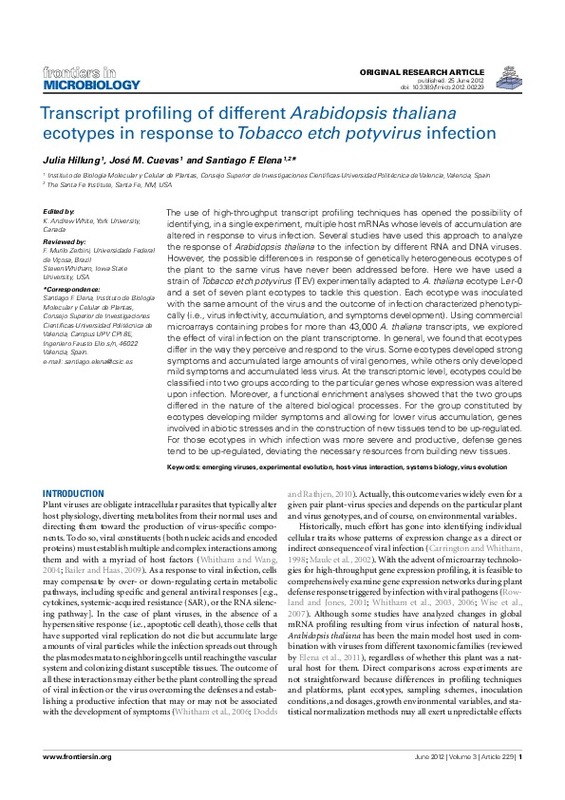JavaScript is disabled for your browser. Some features of this site may not work without it.
Buscar en RiuNet
Listar
Mi cuenta
Estadísticas
Ayuda RiuNet
Admin. UPV
Transcription profiling of different Arabidopsis thaliana ecotypes in response to Tobacco etch potyvirus infection
Mostrar el registro sencillo del ítem
Ficheros en el ítem
| dc.contributor.author | Hillung, Julia
|
es_ES |
| dc.contributor.author | Cuevas Torrijos, Jose Manuel
|
es_ES |
| dc.contributor.author | Elena Fito, Santiago Fco
|
es_ES |
| dc.date.accessioned | 2016-07-18T12:23:53Z | |
| dc.date.available | 2016-07-18T12:23:53Z | |
| dc.date.issued | 2012-06 | |
| dc.identifier.issn | 1664-302X | |
| dc.identifier.uri | http://hdl.handle.net/10251/67743 | |
| dc.description.abstract | The use of high-throughput transcript profiling techniques has opened the possibility of identifying, in a single experiment, multiple host mRNAs whose levels of accumulation are altered in response to virus infection. Several studies have used this approach to analyze the response of Arabidopsis thaliana to the infection by different RNA and DNA viruses. However, the possible differences in response of genetically heterogeneous ecotypes of the plant to the same virus have never been addressed before. Here we have used a strain ofTobacco etch potyvirus (TEV) experimentally adapted to A. thaliana ecotype Ler-0 and a set of seven plant ecotypes to tackle this question. Each ecotype was inoculated with the same amount of the virus and the outcome of infection characterized phenotypically (i.e., virus infectivity, accumulation, and symptoms development). Using commercial microarrays containing probes for more than 43,000 A. thaliana transcripts, we explored the effect of viral infection on the plant transcriptome. In general, we found that ecotypes differ in the way they perceive and respond to the virus. Some ecotypes developed strong symptoms and accumulated large amounts of viral genomes, while others only developed mild symptoms and accumulated less virus. At the transcriptomic level, ecotypes could be classified into two groups according to the particular genes whose expression was altered upon infection. Moreover, a functional enrichment analyses showed that the two groups differed in the nature of the altered biological processes. For the group constituted by ecotypes developing milder symptoms and allowing for lower virus accumulation, genes involved in abiotic stresses and in the construction of new tissues tend to be up-regulated. For those ecotypes in which infection was more severe and productive, defense genes tend to be up-regulated, deviating the necessary resources from building new tissues. | es_ES |
| dc.description.sponsorship | We thank Francisca de la Iglesia, Javier Forment, and Maria A. Martinez-Godoy for excellent technical assistance; Miguel A. Perez-Amador and Francisco Vera for guidance in the use of Agilent microarrays; and Guillermo Rodrigo for help with microarray analyses. This work was supported by grant BFU2009-06993 from the Spanish Ministerio de Ciencia e Innovacion (MICINN) to Santiago F. Elena. Julia Hillung was supported by a fellowship from MICINN. Jose M. Cuevas was contracted under the CSIC JAE-doc program. | en_EN |
| dc.language | Inglés | es_ES |
| dc.publisher | Frontiers Media | es_ES |
| dc.relation.ispartof | Frontiers in Microbiology | es_ES |
| dc.rights | Reserva de todos los derechos | es_ES |
| dc.subject | Emerging viruses | es_ES |
| dc.subject | Experimental evolution | es_ES |
| dc.subject | Host-virus interaction | es_ES |
| dc.subject | Systems biology | es_ES |
| dc.subject | Virus evolution | es_ES |
| dc.title | Transcription profiling of different Arabidopsis thaliana ecotypes in response to Tobacco etch potyvirus infection | es_ES |
| dc.type | Artículo | es_ES |
| dc.identifier.doi | 10.3389/fmicb.2012.00229 | |
| dc.relation.projectID | info:eu-repo/grantAgreement/MICINN//BFU2009-06993/ES/Biologia Evolutiva Y De Sistemas De La Emergencia De Fitovirus De Rna/ | es_ES |
| dc.rights.accessRights | Abierto | es_ES |
| dc.contributor.affiliation | Universitat Politècnica de València. Instituto Universitario Mixto de Biología Molecular y Celular de Plantas - Institut Universitari Mixt de Biologia Molecular i Cel·lular de Plantes | es_ES |
| dc.description.bibliographicCitation | Hillung, J.; Cuevas Torrijos, JM.; Elena Fito, SF. (2012). Transcription profiling of different Arabidopsis thaliana ecotypes in response to Tobacco etch potyvirus infection. Frontiers in Microbiology. 3(229):1-9. https://doi.org/10.3389/fmicb.2012.00229 | es_ES |
| dc.description.accrualMethod | S | es_ES |
| dc.relation.publisherversion | http://dx.doi.org/10.3389/fmicb.2012.00229 | es_ES |
| dc.description.upvformatpinicio | 1 | es_ES |
| dc.description.upvformatpfin | 9 | es_ES |
| dc.type.version | info:eu-repo/semantics/publishedVersion | es_ES |
| dc.description.volume | 3 | es_ES |
| dc.description.issue | 229 | es_ES |
| dc.relation.senia | 232213 | es_ES |
| dc.contributor.funder | Ministerio de Ciencia e Innovación | es_ES |
| dc.contributor.funder | Consejo Superior de Investigaciones Científicas | es_ES |








